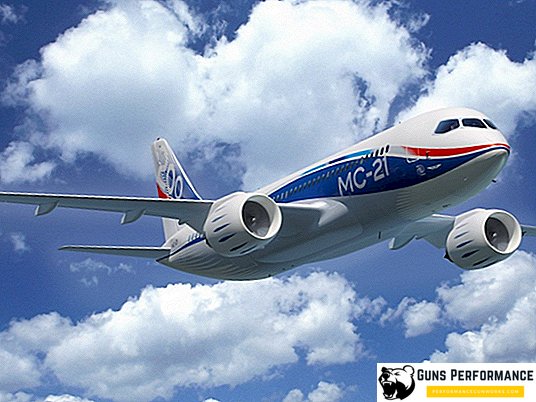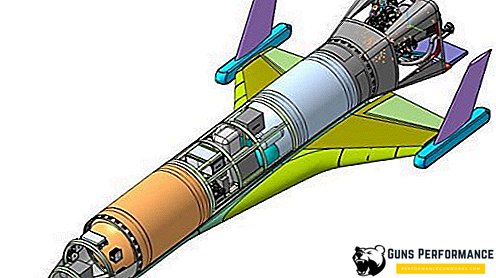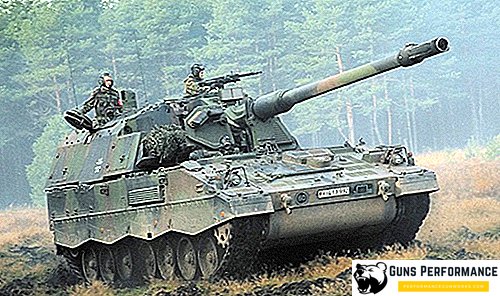
On May 28, 2018, a landmark event occurred for the domestic aviation industry: the newest Russian passenger airliner MS-21 departed from the airfield of the Irkutsk Aviation Plant on its first flight. After the successful completion of the tests, President of Irkut Corporation PJSC Oleg Demchenko called this event historic and congratulated the company's staff. And such a statement does not seem an exaggeration: the excellent flight performance of the MS-21 passenger aircraft gives hope that this airliner will be in demand in the future by both Russian and foreign airlines.
Irkut MS-21 is a program to create a new short-and medium-haul mid-body passenger aircraft, which was launched at the beginning of the 2000s. Although, in fact, the MS-21 is not one aircraft, but a whole family of passenger liners, which are distinguished by their passenger capacity, equipment and range. While testing passes MS-21-300, which will be able to take on board 211 passengers. However, another modification of the airliner, the MS-21-200 with a maximum capacity of 165 people, was also developed with it.
Currently, OKB Design Bureau is participating in this project. Yakovlev and Irkut Corporation. Initially, it also involved and OKB them. Ilyushin, but in 2008 this company left the project. It was planned that the new machine will receive the designation Yak-242, but later this idea was abandoned. Airliners are assembled at the Irkutsk aircraft factory.

In the future, the main competitor of the MS-21 mainline will be the Chinese SOMAS S919 airliner, as well as the American Boeing-737 MAX and the European Airbus A320 neo.
It should be noted that the cost of the new Russian aircraft is lower than that of its Western competitors. It will be from 72 to 85 million dollars. The price of the American and European analogues of the MS-21 aircraft ranges from $ 90 to $ 125 million. True, the Chinese SOMAS C919 airliners will obviously cost less than a Russian car.
In total, $ 4.54 billion was spent on the MS-21 project.
For now, the MS-21 aircraft are equipped with American PW-1400G engines, but it is in the plans of the aircraft manufacturers to install the Perm PD-14 on the machine.
The history of the MS-21
Work on the creation of the MS-21 began in 2002. In the middle of the last decade, the main project of the Russian aircraft industry was the Sukhoi Superjet 100 passenger aircraft. When it became apparent that the Sukhoi Superjet project was successfully implemented, the idea arose of creating a larger airliner capable of competing with products from world giants like Airbus and Boeing.
According to the creators of the MS-21 should replace outdated Tu-154 aircraft and other machines, developed in the Soviet period. At the same time, the new liner will not compete with the Sukhoi Superjet 100, but, on the contrary, will complement it. It is believed that in the future, these two aircraft will make up about 80% of our country's passenger aircraft fleet.

Initially, the design offices of Ilyushin and Yakovlev were engaged in the development of the machine, and the direct manufacture of the machines was entrusted to the Irkut Corporation, which today can be called one of the flagships of the domestic aircraft industry. Irkut produces Su-30 combat aircraft, Yak-130 training aircraft, and also manufactures some passenger vehicle components for Airbus. In 2008, the Design Bureau. Ilyushin left the project and specialists of the Yakovlev design bureau were engaged in its completion. It must be said that many other Russian enterprises participated in the creation of the MS-21, for example, the unique composite wing of the aircraft was developed by the Aerocomposite Concern, and tail fins were created in the OKB Design Bureau. Beriev.
It can be added that the MS-21 has a larger number of Russian components compared to the Superjet: 80% versus 60%.

Aircraft manufacturers had ambitious plans, in 2009 it was announced that the new aircraft would take off in 2013, and its mass production would begin by 2018. However, due to underfunding and difficulties encountered at the design stage, the timing had to be postponed. In 2010, TsAGI purged the engines of the future aircraft and made recommendations for their further operation.
In 2011, the management of the corporation "Irkut" stated that the developers' priority is to create a modification of the MS-21-300 aircraft with a passenger capacity of 211 seats, since most potential customers are interested in this particular machine. Work on the modification of the MS-21-400 (more than 200 seats) and decided to postpone until better times to fit into the program budget.
In 2012, Irkut signed a cooperation agreement with Pratt & Whitney, a famous American company engaged in building engines for civil and military aircraft. According to this document, the MS-21 was planned to be equipped with PW1400G engines.
In 2012, a demonstration of the aircraft project with domestic PD-14 engines took place. This car was planned to be made for Russian customers, such as the Ministry of Defense, the Ministry of Emergency Situations, the Federal Security Service and others.

In early 2014, the assembly of prototypes of the airliner began at the Irkutsk Aviation Plant. In the summer of the same year, a large-scale model aircraft was tested at TsAGI.
It should be said that during the implementation of the MS-21 project in Russia, a new bench base was created from scratch, at which individual components and assemblies of the future machine were tested for strength and fatigue, and their aerodynamic qualities were also tested. It can be added that the implementation of this project gave a powerful impetus to the development of enterprises that are part of UAC. There was a significant re-equipment of the production facilities involved in the production of the aircraft. Thanks to the implementation of the MS-21 project, new high-tech companies appeared in the country.
A few months later, Deputy Prime Minister Rogozin announced the date of the first flight of the liner - April 2018. However, even with this deadline, there was a blunder: on June 8, 2018, only the first presentation of the airliner took place - the solemn ceremony of rolling out the aircraft from the factory hangar took another year to prepare the first flight of the vehicle. The first tests of the aircraft were carried out on a regular basis, the pilots highly appreciated the piloting qualities of the new machine.
At the present moment, two MS-21 aircraft have already been manufactured, another eight are in production.

Previously, the manufacturer’s plans to produce 72 MS-21 aircraft per year were voiced. The project will begin to make a profit only after the sale of the 350th airliner. Back in 2018, Irkut reported that they already have a solid package of orders for 175 aircraft, part of which have already received prepayments. Most potential customers are domestic aviation and leasing companies. Also reported on the interest from Iranian, Indian and Indonesian companies. All in all, the developers are planning to implement 1 thousand aircraft for twenty years.
Description of the design of the aircraft MS-21
The MS-21 passenger plane is made according to a scheme that is classic for machines of this type and purpose. This is a twin-engined low-wing with a wing that has a small sweep and three-bearing chassis. It should be noted that the MS-21 project envisaged the development of several modifications of the aircraft, differing in their passenger capacity and fuselage length. Also, initially there were plans to create a passenger liner with a longer range of flights within this project.
Composite materials are widely used in the construction of the MS-21 airframe. In terms of their application (about 40%), this Russian aircraft is at the level of the world's best analogues and is second only to the latest American (Boeing 787 Dreamliner - 50%) and European cars (Airbus A350 XWB - 53%). The wing of the MC-21 is completely made of carbon, which made it much easier.

The MS-21 has a fuselage of considerable diameter, as for aircraft of its class (more than 4 meters), which provides its passengers with a level of comfort comparable to wide-body airliners. It is made mainly of aluminum alloys. The design of the aircraft was originally laid the possibility of repackaging the cabin, depending on the needs of a particular airline.
The MS-21 has a classic three-bearing chassis, consisting of two main and front strut. All three pillars have two-wheeled carts; on a heavier version of the MS-21-400, chassis with four-wheel carts will be installed.
The landing gear for MS-21 aircraft is manufactured by the Gidromash concern, they are mainly made of steel and titanium alloys.
One of the main highlights of the MS-21 airliner is its wing, completely made of composite materials. Due to this, it was possible to significantly reduce its mass, fully retaining the strength and performance characteristics. The "black" wing of the MS-21 was developed and is currently manufactured by the concern "Aerocomposite". It is likely that in the coming years this airliner will be the only aircraft of this class in the world with a wing of this design. Also the tail of the liner is made of composite materials.

The MS-21 cockpit has five widescreen displays that display information about the operation of the aircraft’s systems and flight parameters. Previously, similar displays in Russian civil aviation were not used.
More recently, the crew of passenger aircraft consisted of four people: two pilots, a navigator and a flight engineer. Modern airliners are usually operated by two people, the remaining functions are taken over by electronics.
At the MS-21 flight control is carried out using the side stick - special control knobs. At the request of the customer, the aircraft can be equipped with indicators on the windshield of the cockpit or synthetic vision - a special system that displays the space surrounding the aircraft on electronic displays. This system makes it easier to control the machine in case of loss of visual visibility due to bad weather conditions or the time of day. To facilitate the work of pilots, special electronic tablets have been developed for them.
Most of the MS-21 on-board electronics are designed and manufactured in Russia in close cooperation with world leaders in this field - the Rockwell Collins and Thales companies.

One of the global trends in aircraft construction is a constant increase in the level of comfort for passengers. The MS-21 absolutely follows this trend: the considerable width of the fuselage allows you to increase the size of the cabin and the aisles between the seats, which significantly reduces the time of embarkation and disembarkation of passengers. For the airliner, special passenger seats were developed that are convenient for people of various sizes, and special places for disabled people are provided. Salon MS-21 will be equipped with the latest multimedia devices for watching movies and playing computer games.
Passenger cabin liner has large windows that provide sufficient natural light. The intensity of artificial lighting will vary depending on the time of day, which will allow passengers to more easily endure the change of time zones. In addition, designers paid much attention to the microclimate in the cabin: the plane is equipped with a special air conditioning and air humidification system, it passes through several biological filters, and the temperature is regulated.

In general, the layout of the passenger compartment MS-21 will maintain two classes of comfort: economy and business class. Based on the wishes of customers, the liner may have one or two classes in the cabin.
The development of life support systems for the passenger compartment MS-21 was carried out by the Russian NGO Science in close cooperation with the American company Hamilton Sundstrand. The interior design was created by the French company C & D Zodiac.
Almost 20% of the volume of the MS-21 fuselage is occupied by baggage compartments. The aircraft will be able to transport cargo in special containers or in bulk. At the same time, the luggage compartment of the liner has an automatic loader, the use of which significantly reduces the time for unloading or loading baggage.
Airliner MS-21 can be equipped with two types of engines: the American PW1400G, developed by Pratt & Whitney or domestic PD-14, which has been developed by Aviadvigatel OJSC since 2008. While the planes will be installed on the PW1400G, these engines are currently considered among the most advanced in the world, they are used on Airbus, Mitsubishi, Embraer and Bombardier passenger liners.
Domestic aviation engine PD-14 is currently being tested, it is planned that its mass production will begin next year.
It should be noted that all types of engines that will be equipped with different models of the MS-21, comply with international environmental standards and standards.
Modifications aircraft MS-21

As mentioned above, the MS-21 is a whole family of passenger aircraft. It consists of several modifications that have a very high degree of unification:
- MS-21-200. It is considered the most "junior" version of the aircraft. Its passenger capacity is 165 passengers in a single-class layout. The take-off weight of the car is 72.5 tons, it is planned that it will be equipped with PD-14A or PW1428G engines. Air carriers have shown less interest in MS-21-200 than in the basic modification, so its production will be started later;
- MS-21-300. This is a basic modification of the aircraft. It has a fuselage 8.5 m longer than the MS-21-200. Passenger capacity of this model can reach 211 people in a single-class layout. The take-off weight of the car is 79.2 tons, it is equipped with engines PW1431G or PD-14. This modification of the aircraft caused the greatest interest among potential buyers, so mass production will begin with it. The prototype liner is a modification of MS-21-300;
- MS-21-400. A larger version of the airliner. It differs from the basic modification by the increased dimensions of the fuselage and the wing; it is also likely to have a four-wheeled chassis trolley (according to other sources, also a four-rack chassis). The passenger capacity of the MS-21-400 will be 230 people, the take-off mass of the aircraft is 87.2 tons. The liner is planned to equip with a forced engine PD-14M. Due to the rather serious changes that had to be made in the construction of the MS-21-400 compared to the base model, the development of this aircraft was postponed.
In the case of a successful launch of a new project, Russian aircraft manufacturers plan to significantly expand the MS-21 family, adding to it aircraft with longer range and passenger capacity. Will they be implemented, will show the near future.
Prospects for MS-21
The Russian aviation industry is pinning great hopes on the MS-21. Most of the new domestic aircraft are produced in such small quantities that manufacturers can not even "beat off" on them the costs associated with the development.
Over the years, the Soviet and then the Russian aviation industry was engaged in the development of many projects that remained at the stage of design development or the creation of experimental models. Especially often this happened with passenger aircraft. Moreover, many domestic cars that never saw the sky had very good flight performance, and even surpassed foreign competitors in some parameters. Is there a future for the MS-21, given the highest level of competition that prevails in this area?

MS-21 is a medium-haul airliner, that is, it belongs to the most numerous niche of passenger aircraft. Now these machines occupy 78% of the total number of commercial passenger liners. To estimate the size of this market segment, you can only give one figure: in the next twenty years, 30 thousand medium-haul aircraft will be sold in the world. That is, potentially MS-21 has excellent prospects.
However, competition among aircraft manufacturers is unusually high. Currently, the niche of mid-range aircraft is almost completely closed by the Boeing 737 and Airbus A320. On May 7, 2018, the Chinese medium-haul passenger airliner Comac C919 made its first flight, and its launch is planned for 2020. According to its characteristics, it is very similar to MS-21-300, however, there is almost no doubt that the new “Chinese” will cost much less, not only for its Western counterparts, but also for the Russian aircraft. Now called the figure of 50 million dollars. The Chinese manufacturer has already announced that today it has a package consisting of 517 firm orders for the C919.
On the other hand, it can be stated that Russian aircraft manufacturers were able to create a really good car, not inferior to Western counterparts.
This machine will be equipped with the latest Western engine, environmentally friendly and economical, which can be called an undoubted advantage of the project. Ибо задача уговорить иностранных заказчиков закупать пассажирский лайнер с российским двигателем невероятно сложна. С момента распада СССР отечественная авиадвигателестроительная отрасль не создала ни одного нового мотора для пассажирских лайнеров и заметно отстала от основных мировых производителей. Даже двигатель для "Сухого Суперджета" пришлось создавать в кооперации с французами. ПД-14 придется сначала обкатывать на внутрироссийских линиях, а уж только потом предлагать за рубеж.

Еще одним несомненным преимуществом является композитное крыло МС-21. Во-первых, оно имеет отличные аэродинамические характеристики, а, во-вторых, уменьшает массу самолета, что позволяет сэкономить топливо.
МС-21 имеет бортовую электронику с так называемой открытой архитектурой, что позволяет устанавливать на него оборудование любых производителей. Кабина пилотов и пассажирский салон выполнены по последним мировым стандартам.
Так как МС-21 - это новый самолет, то в его конструкции изначально был заложен большой объем багажного отделения, вместительные багажные полки, удобные и широкие кресла, а также значительные проходы между ними. Существующие и перспективные среднемагистральные самолеты Airbus и Boeing - это модификации старых моделей, унаследовавшие их фюзеляжи. Поэтому подобных удобств своим пассажирам они предложить не смогут.
Кроме вышеперечисленных преимуществ, МС-21 имеет вполне конкурентную цену по сравнению с западными аналогами. Однако дело в том, что цена самолета, указанная в каталоге, это только один из факторов, который определяет выбор той или иной модели лайнера покупателем.
Огромным минусом российских самолетов является практически полное отсутствие системы послепродажного обслуживания. Например, клиенты компании "Боинг" получают гарантию (обычно 3-4 года) на основные узлы самолета. Кроме того, покупатели лайнеров Airbus и Boeing знают, что в случае необходимости новая деталь будет доставлена в любую точку планеты в течение 12-14 часов. Также потенциальным клиентам, как правило, предлагают целый пакет финансовых опций (условия платежей, лизинг, кредиты на покупку). Европейские и американские производители за десятилетия сумели создать сложную систему привлечения заказчиков, и ни Китаю, ни России пока нечего противопоставить этому.
Впрочем, несмотря на довольно неясные коммерческие перспективы российского авиалайнера, МС-21 все равно уже можно считать прорывом для отечественного авиастроения. Неизвестно, окупятся ли миллиарды, которые государство вложили в создание новых производственных мощностей и постройку опытных машин, но в любом случае проект МС-21 - это значительный шаг на пути выхода России на международный авиационный рынок.
Технические характеристики МС-21













